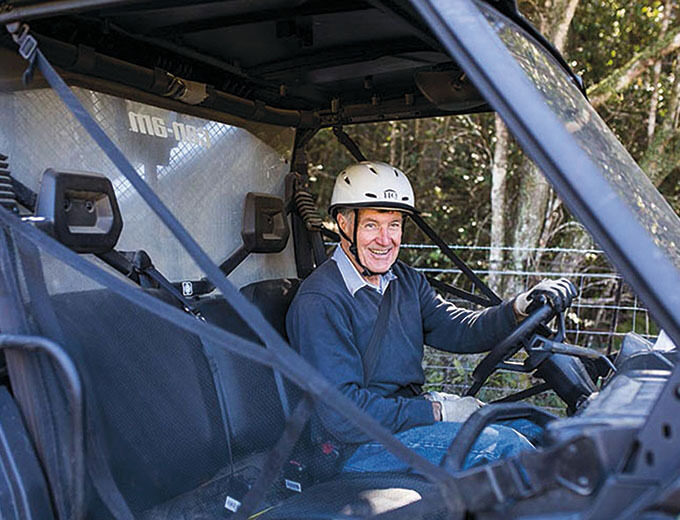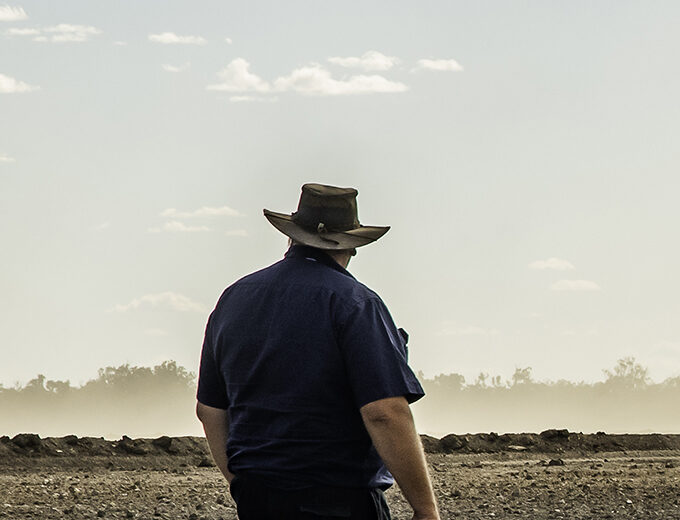The biggest factor we can address to improve farm safety is to ‘just slow down’ according to Dalby (Barunggam country) cotton and grain growers Steve and Bridget McVeigh.
With the latest farm safety figures showing deaths due to side-by-side vehicles have jumped from four to 14 in one year, Steve is shocked but not surprised.
“After a few incidents with quad bikes over the years we moved right out of them a little while ago to side-by-sides: and while I feel they are safer, they are still one of the most dangerous bits of equipment we run on our farms,” he says.
The alarming death statistic comes from the AgriFutures Australia 2024 AgHealth Australia annual report, showing deaths and serious injury more than doubled on 2023 figures, with 72 deaths and 133 serious injuries on Australian farms. There was one death on a cotton farm in 2024 attributed to a side-by-side vehicle.
The uptake of side-by-sides for safety reasons has not reduced the number of deaths from quad bikes, which doubled from five to 10 and were by far and away the main cause of serious injuries with 46 incidents. The next closest cause were horses, with 14 serious injuries (serious injury is defined as requiring more than five days off work.)
Both quad bikes and side-by-sides were responsible for the greatest increase in fatalities and are the leading causes.
Steve says he sees several reasons why side-by sides aren’t living up to the reputation of being safer.
“Because they are high speed and not really considered as needing a skill set to drive them, which is where things go wrong,” he says.
“There are options – we can get slower ones that make them a little safer – but the main thing that needs to happen is people need to be trained on how to properly operate them and be well aware of their limitations.
“Further to that, like all machinery, maintenance is not just to keep them running, but running safely.”
Figures prompt industry campaign
The AgHealth report has been referenced by the Federal Chamber of Automotive Industries (FCAI) to launch a safety campaign for side-by-side vehicles, focusing on safe use, including a website. The FCAI and members BRP, Honda, Kawasaki, Polaris and Yamaha jointly commissioned the development and deployment of the campaign.
“All over Australia, ATVs and side-by-side vehicles are used as versatile ‘tools of trade’ and can be an important part of farm machinery,” FCAI Chief Executive Tony Weber said.
“Regardless of how, where and when they are used, recognition and application of safety procedures remain critical.
“It is especially important to supervise younger riders and ensure they only ride age-appropriate vehicles and wear appropriate safety equipment, while older drivers should review safety protocols and consider the operating conditions before using the vehicles.
“There is no doubt that incidents involving these vehicles are avoidable if they are driven according to the conditions and all safety protocols are followed.”
In light of these recommendations, the McVeighs are way ahead of the game. It comes as no surprise to many in the cotton industry, as they were acknowledged at the 2024 Australian Cotton Awards with the Agri Risk High Achiever Award, in part for their proactive and innovative on-farm safety protocols. Steve has some strong opinions about side-by-sides.
Proactive and innovative approach to safety
All of Steve’s staff undertake an induction on safe operating of all equipment, including side-by-sides. QR codes are on all their machinery. When scanned it takes the user to the safe operating instructions.
“It’s all in the training,” Steve said.
“Inductions and training in safe operating equipment operation has to be done, it’s a part of farming.
“It has to then be backed up with continual attention to safety, because as farmers we run in a risky environment so need to put things in place to manage safety.”
For the McVeighs, this includes a WhatsApp group covering safety and maintenance.
“If something is raised in the WhatsApp group as unsafe it is documented on a spreadsheet and actioned, and I’ve found having one person responsible for managing that is ideal.
“That way, no-one assumes someone else is going to handle a safety issue or hazard, we know actions to fix issues will happen and our records will be updated.”
But it’s not just identifying hazards and fixing them for Steve. Safety is paramount but maintenance is a part of that. Cleverly, the QR code on each piece of machinery has been designed to also record and show the maintenance record of each piece of equipment, as well as the hours and by whom they were worked. Unlike large, expensive machinery, maintenance on quad bikes and side-sides may be overlooked.
“Like the run-around tractor on the farm, maintenance of these vehicles can be overlooked in the day-to-day running of our farming operations,” Steve said.
“It’s worthwhile having a set person for maintenance – having one person look over and be responsible for our farm machinery maintenance works for us, as it means nothing is overlooked when we get busy or focused on other projects.”
Sales show broad uptake
The uptake of side-by-sides has been swift, due to the perception of offering a safer and more versatile alternative to a quad bike.
Sales figures of side-by-sides from leading manufacturer Polaris show that they were set to overtake quad bikes in 2017, and it was predicted that this would continue with quad bike sales estimated to be close to zero in 2024. At the time, Polaris said the speed of the trend was driven by a wider range and price of side-by-side type vehicles along with a perception by users and regulators of their relative safety compared to quad bikes.
Wear a helmet and seatbelt
Farm safety is an issue taken seriously by cotton industry bodies. Cotton Australia represents the industry as a member of FarmSafe, helping to advocate farm safety messaging in line with the industry’s myBMP program. CRDC supports improving farm safety as a member of the Rural Safety & Health Alliance (RSHA), a collaboration with other Research and Development Corporations (RDCs) into relevant research and development.
“Cotton moved heavily to side-by-sides because they were seen as safer, could carry a passenger, a load in the back and a roof over our heads to protect us from the elements,” Cotton Australia’s Paul Sloman said.
“This has potentially created a false sense of security. A lack of safety awareness, not wearing seat belts and too much speed is resulting in people being ejected from the vehicles at speed.
“Basically, if you don’t wear a seat belt, it’s the same as a quad runner.”
Paul says the McVeigh’s attitude and commitment to training and maintenance should be standard across the industry.
“I agree with Steve: while there are risks, there are safe, practical ways to use side-by-sides,” he said.
“Slow down, wear a helmet and put the seatbelt on, because the consequences of not doing so are far reaching: death and/or serious injury affects your farm, your family and your wider community.
“On the training side, make sure inductions are practical and thorough – how to drive one safely, their limits and other safety considerations such as wearing a helmet.
“Further to personal safety, from a legal perspective, all staff need to be inducted in all machinery and provided personal protective equipment. If an employer can’t provide evidence of meaningful induction, they’re opening themself up to litigation.
“This should not be the leading impetus for addressing farm safety though. It’s about providing a workplace where people go to work and are coming home safely.
“I think these recent report figures show that agriculture as an industry needs to look at how we are talking about farm safety, and how we can help growers adopt best practice in health and safety, like Steve has.”
CRDC Innovation Broker Rachel Holloway leads CRDC’s involvement in the RSHA.
“RSHA is leading an important WHS research project, the Ag Safety Data Net, to provide agricultural industries with consistent WHS metrics. This will ensure all ag industries can report on farm safety consistently, to help us understand what is happening on farm, to help make change and to make farms safer for everyone,” Rachel said.
“Farm safety is a collective effort – it’s important that we bring together industry leaders, researchers and policy makers to discuss and agree evidence-based solutions.
“The current WHS data on side-by-sides will hopefully drive awareness and change. The stark reality is that fatalities and injuries are occurring on farms.”
Creating a space for safety
Steve says he understands safety is a subject often not viewed with a great deal of interest.
In terms of cotton farming aspects that can be focused on, WHS has often been viewed as a necessary as opposed to voluntary action, and not seen as central to the farming operation.
The long-term average for the cotton industry is one death per year. That’s one too many.
“One is one too many, and I think what is needed to get the message through to our people is to care about safety,” Steve says.
“We want to encourage younger people into farming, and I feel sometimes there is a fine line in running a farm and enjoying it, because there is a lot we have to consider and adhere to.
“Safety is a serious and necessary subject, but we can approach safety with our staff with understanding as opposed to presenting a list of rules and regulations: we have to be able to say ‘I’ve made those mistakes’. We’ve all been guilty of doing unsafe things as some point.
“Farm safety is about understanding the risks and doing your task in a safe way.
“The big way to reduce risks across the farm is to just slow down, because when people are in a rush, that’s when accidents happen.
“Everyone deserves to come home at night. We can’t put a price on life, so safety is paramount.”
For more
www.sidebysidesafety.com.au
Rachel Holloway
[email protected]
Paul Sloman
[email protected]
This article appears courtesy of the Cotton Research and Development Corporation (CRDC). It was published in the (Winter 2025) edition of CRDC’s Spotlight magazine: www.crdc.com.au/spotlight


